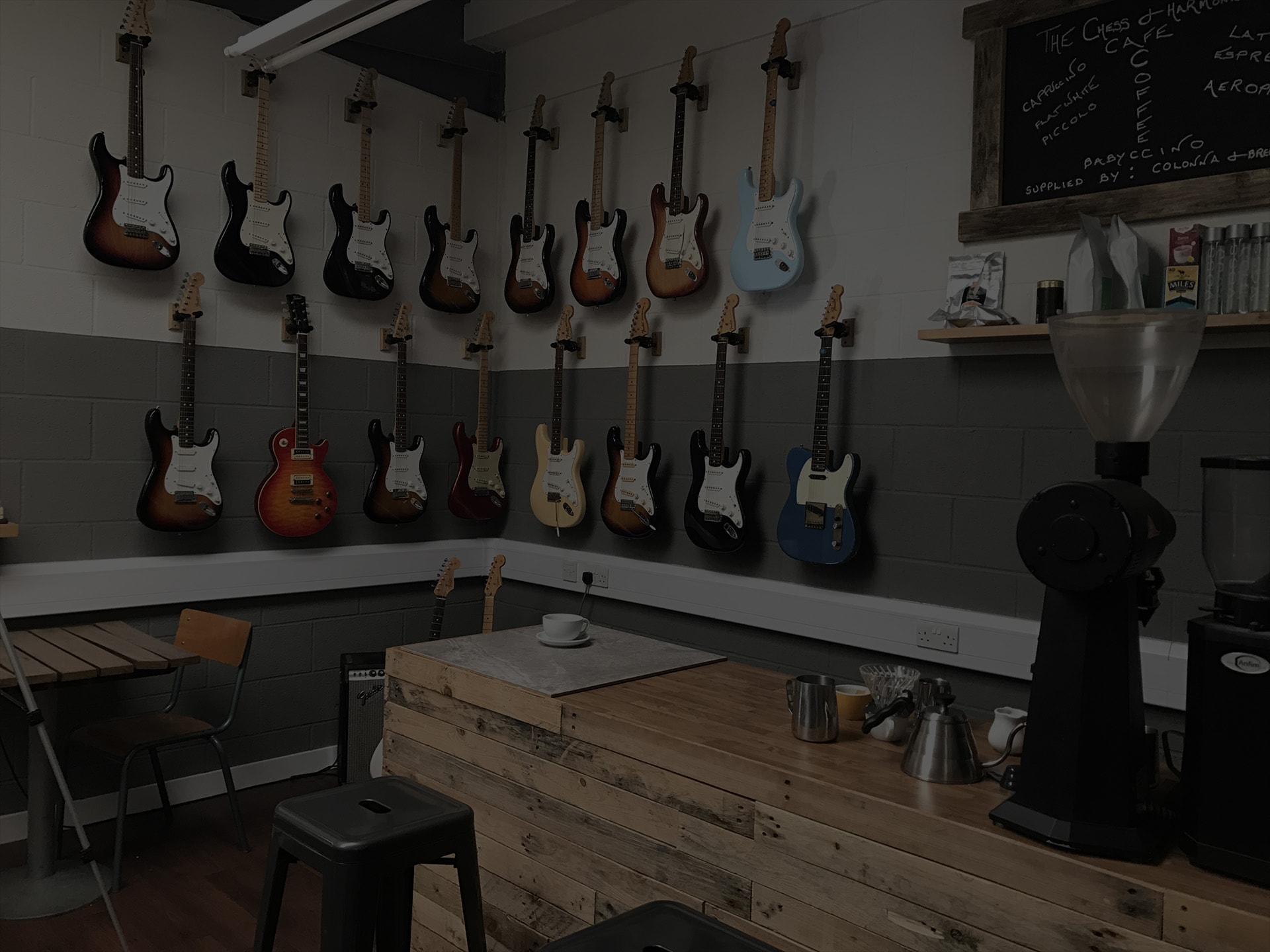The origins of this world famous American brand date back to 1938 when a man named Leo Fender set up a small radio repair business called ‘Fenders Radio Service’. Leo was an electronics engineer and enjoyed repairing and working on all kinds of amplifiers, record players and radios. He then became interested in the amplifiers used by musicians.

Leo Fender
You have to bear in mind that in those days the notion of an amplified electric guitar was not commonplace at all. The guitar was largely a background instrument that was played acoustically in a band with no amplification. What Leo Fender didn’t realise was that he was about to become a pioneer in a complete revolution of modern guitar sounds.
Leo was fascinated by Hawaiian Lap Steel music and concentrated many of his early efforts in creating lap steel guitars and amplifiers to suit. By 1946 the Fender Electric Instrument Company was formed and Leo Fender was about to start making history.

An Early 50s Fender ‘Champion’ Lap Steel
By 1950 he’d created his very first solid body electric guitar, the Broadcaster which later became the Telecaster. This was a huge departure from conventional electric guitars of the era. A solid body, solid maple neck (one piece) and a bolt on neck to body join. It was a far cry from the highly crafted Gibson’s of the era and many people initially dismissed it as a rather odd and novel guitar.

A 1950 Fender Broadcaster
By 1953 the first Stratocaster prototypes were beginning to come to life and a year later Leo made history with his release of this iconic guitar. For the mid 50s it was a hyper modern instrument with a cool modern name. It looked nothing like any other guitars of the time.

A Fender Stratocaster from 1954
The success of the Stratocaster, or Strat as it became known, propelled Fender onto the world stage. Their range of guitars and amplifiers were being sold all over the globe. By the 1960s the Fender brand was appearing on stages and on television sets in the hands of famous musicians with numerous musical genres adopting the instruments.
During the mid 60s Beatles guitarist George Harrison was keen to get his hands on a Strat citing that he simply wasn’t happy with the guitar sound he had. In a 1993 interview for the superb TV documentary ‘Curves Contours and Body Horns’ he recounts a story of how he once saw a Strat for sale in Hamburg Germany, went to buy it but was too late. Someone else had got up earlier and gone and bought it.
Later on Brian Epstein, the Beatles manager was offered a sum of money by Fender to get the Beatles playing Fender instruments on stage. Astonishingly he refused! A seemingly crazy decision but who knows, maybe someone else made him a better offer? After the mid 60s Harrison got his hands on a blue Stratocaster which was used on many Beatles albums thereafter. He was seen holding that same guitar during the filming of the documentary in 1993 and presumably kept it until he died.
Sale to CBS Corp
By 1965 Leo Fender had had enough of the business. There were both business and personal reasons involved but the upshot was that in 1965 Fender Musical Instruments was sold to the giant CBS corporation. There is little doubt that among Fender collectors, players and enthusiasts this sale marked a huge line in the sand for the company and their product.
The general consensus is that after the CBS take over the quality, feel and vibe of the Fender products took a downturn. It must be noted however that this was a very gradual process. I’d argue that some changes they made were excellent. Many Fender instruments and amps from the late 60s are superb and remain extremely collectible. By the 1970s however things started to take a bit of a turn for the worse.

A 69 Strat, quite a different beast to the 1954 edition but still excellent guitars
By the mid 70s the guitars looked and felt nothing like their earlier ancestors. They had become mass produced, using cheaper materials and had been made at a cost, for a profit on an accountant’s ledger rather than a cherished instrument in the hands of a musician.
By the end of the 70s Fender were in real trouble, their reputation as a quality manufacturer was in tatters and a host of competitors had entered the marketplace. The Japanese were starting to produce copies of Fenders that were better than the new originals. Their iconic product, the Stratocaster, had become a fat, plastic like, tinny sounding instrument that weighed a ton and sounded crap.

A 1979 Stratocaster – probably the worst year of production
By the early 80s changes were afoot, some new management were brought in and things started to improve. The Stratocaster in it’s current form underwent a major update. Some small scale production began on replicas of their original 50s and 60s guitars in the form of the American Vintage Reissue series. Many of the CBS changes to the products were scrapped as they made a huge effort to get back on track. Sadly it was too little too late and although they made some incredible guitars during this brief period (1982 – 84) CBS decided to offload the failing guitar company.
New beginnings and a new factory
In 1985 some Fender management and investors bought the selected assets of the Fender company from CBS. This didn’t however include the factory in Fullerton California so a new factory was acquired in Corona that would remain Fenders home for the foreseeable future. Things must have moved fast because in 1986 the new American Fenders were rolling off the production line and it was clear that these instruments were nothing like the old CBS versions of the famous instruments.
The new American Standards
The Stratocaster and Telecaster are two of Fenders most popular product lines and the new and improved versions of these classic instruments had essentially been redesigned with a totally different feel to them. They felt very modern indeed. Soft satin finishes on the necks, beautifully engineered metal hardware and some updates that made them suitable for the demands of modern players.
The new models were well received and although they certainly lacked much of the character and cool vibe of their 50s and 60 older relatives, they were still excellent guitars in their own right. When you examine the specifications of them they share almost no common parts from the old CBS Fender days. They represented a completely new start for Fender.

The all new for 1986 American Standard Stratocaster
A catalogue of new models
It really didn’t take long for the new Fender company to amass a large catalogue of new models. The Stratocaster, Telecaster, Jazz Bass and Precision Bass remained the main stay of their range but seemingly endless versions of these four guitars started to appear in the catalogues. Signature versions were created in partnership with some of the worlds most famous players, Yngwie Malmsteen was one of the first artists to get his own signature Stratocaster guitar but other names followed including Eric Clapton, Jeff Beck, James Burton and others.
Prestige models and guitars for modern players
Fender had clearly employed some very clever marketing people and soon their catalogue was swelling with a range of guitars for everyone’s taste. The Stratocaster soon became available in it’s standard form but also a ‘Plus’ version, then a ‘plus Deluxe’ and a range topping ‘Ultra’ that featured an ebony fret board, a more Gibson like radius and a stunning flame maple cap, not very Fender!
These premium models featured Fenders exclusive Lace Sensor pickups and before long models with these new features were finding their way onto huge stages in the hands of the worlds most famous guitar players. During the late eighties and early nineties players were moving into more high tech on stage set ups. Marshall stacks were being replaced with rack mounted gear and more highly processed guitar rigs. These new pickups were perfect for this sort of thing and were widely used in the 1990s.

A Strat Ultra from 1990
Of course today we are right back where things started, small valve combo amps are the order of the day and as such the ultra modern Lace Sensor pickups have been consigned to the dustbin and are more out of fashion than Timmy Mallet at a hipster convention.
Continued evolution
As time moved on so did Fender. They could have simply stuck with their heritage product as it was but it became clear that they were a progressive company who listened to players needs and produced what players wanted. New pickups were designed, and where some of the more ‘modern’ upgrades to the guitars hadn’t really worked, they reverted things back to the more traditional methods.
Today the range of Fender USA guitars is hugely extensive and most of the models from the 80s have been replaced with newer versions. The American standard Strat’s and Tele’s were replaced with the ‘American Pro series’ in 2016 and the American Vintage reissues recently saw their exit from the catalogue in favor of the new ‘American Classic’ series.
There is little doubt that Fender has earned it’s place in American history as something more than just a brand of guitar. Fender has had a huge role in the development of modern music at a time in history that was pivotal to modern popular culture. The sound of modern music would be very different had it not been for that little radio repair shop run by Leo in the late 1940s.

















